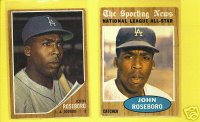on November 22, 2003 in Santa Barbara‚ California.
Crowning the crop of hot young shortstops that emerged in the late 1990s, Garciaparra's amazing debut in 1997 (.306, 30 HR, 98 RBI, 209 hits, 22 steals) made him the second consecutive shortstop (following
Derek Jeter) and just the sixth player ever to be unanimously voted American League Rookie of the Year.
The first Red Sox player to receive the honor since
Fred Lynn in 1975, Garciaparra's team-high RBI total set a major-league season mark for RBI by a leadoff hitter and his 30 homers established a new major league rookie record for shortstops. His 30-game hitting streak from July 26 to August 29 broke
Guy Curtright's 1943 AL rookie record by four games and also tied
Tris Speaker for the second-longest hitting streak in Red Sox history.
Garciaparra also broke a couple of longstanding Boston records. His AL-leading 209 hits broke
Johnny Pesky's 1942 rookie record of 205 (during the season, Pesky pronounced him the best shortstop in Red Sox history) and his 365 total bases smashed
Ted Williams' rookie record of 344 in 1939. Garciaparra's 11 triples also led the American League. While pacing the Sox in at-bats (684) and finishing second in HR and doubles (44), Nomar became the first Red Sox player to reach double figures in doubles, triples, homers and steals since
Jackie Jensen did it in 1956.
"Numbers swirled around him like a disco ball," wrote Baseball America, and by the end of the season, Garciaparra was so tired of listening to reporters enumerate his achievements that he pleaded before every interview, "no more questions about stats, OK?"
Known as "Glass" in high school due to his brittle appearance and slender physique, Nomar almost didn't make it to Boston. After he tore up his knee at Pawtucket in early 1996 it was thought that he was gone for the season. But he was back by June, hit .343 with 16 homers and 46 RBI in 43 games and was quickly pegged as Red Sox shortstop of the future. He added four homers and 14 RBI in 24 games during a brief call-up in late 1996, when he became Red Sox' starting shortstop.
In spring training 1997, a minor controversy erupted over this appointment when new Red Sox manager
Jimy Williams moved the incumbent shortstop,
John Valentin, to second base, and
Wil Cordero, who'd already accepted a move to second from short, was shifted again to DH. But the controversy blew over when it became clear that Garciaparra's talent became evident. Garciaparra's fine season also partially salved Boston fans' anger at losing
Roger Clemens after the star hurler signed with the Toronto Blue Jays before the 1997 season.
A slave to routine at the plate (he has a habitual pattern of adjusting his wristbands, kicking the dirt, and genuflecting before every pitch) and superstition on the field (he refuses to wash his hat during the season) Garciaparra continued his torrid pace in 1998, batting .323 with 35 homers and 122 RBIs. When slugging first baseman
Mo Vaughn left Boston for Anaheim as a free agent after the season, the quiet Garciaparra inherited the role of team leader at the tender age of 25.
Garciaparra was selected by the Boston Red Sox in the first round (12th pick overall) of the 1994 June draft following three years at Georgia Tech and a stint with the 1992 U.S. Olympic Team. Garciaparra's first name is actually Anthony; Nomar is his middle name, and is Ramon, his father's name, spelled backwards. (
SW/
JGR) (
Stewart Wolpin) (
James G. Robinson)
Editor's note: Boston traded Nomar to the Chicago Cubs mid-year in 2004 and then he left Chicago after the 2005 season for a one-year contract with the Los Angeles Dodgers. Nomar was voted Comeback Player of the Year for 2006 and then re-signed for another two years with the Dodgers.





 They also had a black outfielder named Harry “Suitcase” Simpson. I will always remember him because he stole a foul ball from me. It’s always a kid’s dream to catch a foul ball at a big-league ball game. One time during practice I was standing near the right-field foul pole, watching, when a ball came right to me. Just as I went to catch it, a big glove jumped in front of my face and took it away from me. It turned out Simpson had stolen it. Usually a big-league ballplayer lets a ked catch a foul ball when it’s hit into the stands in practice. Sometimes they even threw you one they caught near the stands. But Simpson just threw this ball back to the infield, and it steamed me.
They also had a black outfielder named Harry “Suitcase” Simpson. I will always remember him because he stole a foul ball from me. It’s always a kid’s dream to catch a foul ball at a big-league ball game. One time during practice I was standing near the right-field foul pole, watching, when a ball came right to me. Just as I went to catch it, a big glove jumped in front of my face and took it away from me. It turned out Simpson had stolen it. Usually a big-league ballplayer lets a ked catch a foul ball when it’s hit into the stands in practice. Sometimes they even threw you one they caught near the stands. But Simpson just threw this ball back to the infield, and it steamed me.

